By Jeffrey A. Rendall, Photos by Jeffrey A. Rendall
WILMINGTON, DE – If you’re going to play ‘the track’ at Delaware Park, most people would probably believe you’re heading off to lay down some bets on the ponies.
But thanks to some forward looking people at the famous racetrack, you’re just as likely these days (at least when it isn’t racing season) to mean you’re going to play some golf. White Clay Creek Country Club opened in late June of 2005, and ever since, has given Delaware Park a double meaning for ‘track.’
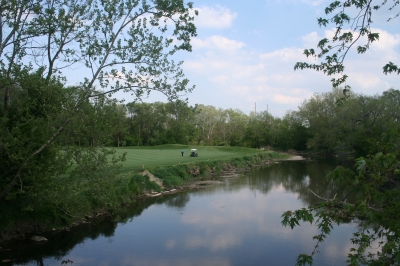 |
| Welcome to White Clay Creek. Looking from the bridge over the creek on the par four 1st hole. Get used to it, you'll see a lot of water on this course. |
Unfortunately for the horses, they don’t have much choice but to run in one direction, but Delaware Park’s golfers are greeted with a multi-dimensional challenge that weaves in, out, and around the limitless property of the racetrack. And if you’re there on a racing day, you’re treated to the sounds of horse racing as well. Having seen a great many golf courses, this one truly stands apart from the rest – largely because of its equestrian flavor.
Bobbi Sample, White Clay Creek’s General Manager, said the golf course was meant to effectively use the vast acreage surrounding the racetrack and casino, but also to enhance and preserve it: “Planning for the golf course began back in 1998, but construction didn’t actually begin until 2002. We had a lot of undeveloped land surrounding the racetrack and casino building – and we tried to find a way to utilize and preserve it. A golf course turned out to be a great way to do both.”
She continues, “With so many wetlands within the area, and with the goal of keeping it as natural as possible, the golf course provided an opportunity to offer a spectacular additional amenity to our casino and racetrack customers.”
And, as it turns out, it’s a gift to golfers in the Mid-Atlantic region as well. I’ve been known to size up the horse-game from time to time, but these days, teeing it up takes precedence to lighting up the Tote board. White Clay Creek gives the Delaware Park folks another attraction altogether, and it’s interesting way to broaden their business.
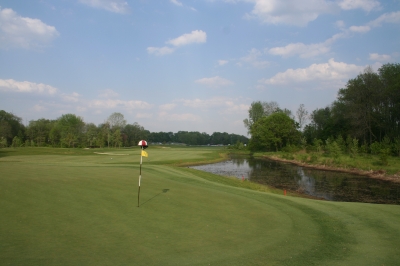 |
| From behind the par five 15th hole. If you're well placed off the tee, you may be able to go at this green in two. But even slight misses can result in severe penalties. |
Delaware Park racetrack has a distinguished history in and of itself. It opened in June of 1937, originally designed by William DuPont Jr. – and its convenient location drew crowds of 20,000 per race day (via train) from throughout the Mid-Atlantic region during thoroughbred racing’s heyday.
The track thrived until the mid 70’s when other racetracks in the region began expanding their schedules, directly competing with Delaware Park – resulting in shrinking attendance and purses. Slots were introduced at the park in 1995, with the purpose of reviving the racing side of the business, and they’ve been successful in doing just that.
“The additional purse money has helped us attract quality race horses, with the likes of Afleet Alex and Barbaro winning their first races here,” Sample said proudly.
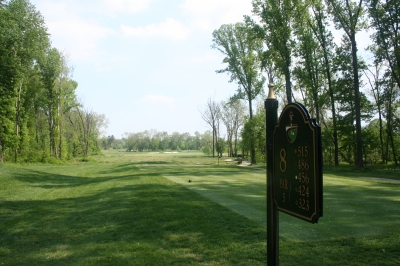 |
| At 515 yards, the 8th hole is White Clay Creek's shortest par five... but that doesn't mean it's easy, as there are several stream crossings between you and the green. |
Perhaps coincidentally, we visited White Clay Creek on Kentucky Derby Day (2006), and it’s safe to say, whenever we think of the golf course, we’ll think of Barbaro as well.
But while you’re out there, it’s hard not to think of the design firm of Arthur Hills/Steve Forrest, because the layout is decidedly challenging and fun to play at the same time. White Clay Creek isn’t for those who can’t hit it straight – but short and straight shooting golfers will find it to their liking, if playing from one of the forward sets of tees. Like most newer vintage golf courses, it’ll test that high-tech equipment you’ve purchased.
Part of the tight nature of the course is due to the land it’s on, and who better to explain why it was tricky to put a golf course there than its architect, Steve Forrest: “By far, the most difficult thing about the White Clay Creek project was building a golf course in a floodplain. From the permitting process to actually dealing with floodwaters from hurricanes and tropical storms, the floodplain issues made everything else seem easy.”
“We were pleased to have an owner (Bill Rickman) who was committed to taking whatever measures were necessary to deal with the various issues associated with trying to create a world class golf course within the difficult natural setting,” Forrest added.
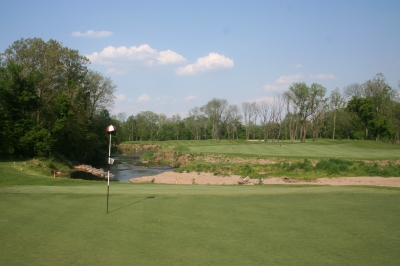 |
| Beauty and challenge describes the 444-yard, par four 11th hole. |
The Hills/Forrest people first heard about the project through Joe Hills (Arthur’s son, and co-owner of a couple Washington DC area courses), who knew Mr. Rickman – then Arthur Hills and Forrest interviewed with Delaware Park’s CEO, Bill Fasy, in December of 1998. The goal was to open the new golf course in time for the track’s centennial celebration, which would take place in July of 2000. Forrest said that might’ve been possible if they’d started right away, but the permitting process wouldn’t allow them that short of a timetable, and then Mother Nature took care of the rest.
Even with the difficulties, Forrest said they grasped the land’s potential right away: “The property was beautiful with its mature trees along White Clay Creek and its tributary. The racetrack and all its trappings also created a unique atmosphere for golf, but also carried with it its own set of issues. We ended up having to visually buffer the practice track, since there was a concern that the golf cars would spook the thoroughbreds.”
Every golf designer encounters problems at each individual site – but the need to avoid scaring horses probably doesn’t come around very often.
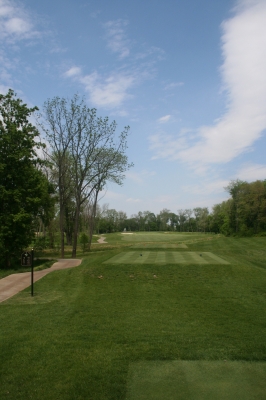 |
| There's not much room to miss side-to-side on the par four 2nd hole. Tee it up with whatever club you can hit straight. |
Whatever the obstacles, White Clay Creek finally opened on June 28, 2005. The initial buzz surrounding the course was that it’s difficult, but very beautiful. I’d say that’s an accurate description.
The most prevalent feature of the course is White Clay Creek itself, which you never quite seem to get away from – that’s the nature of the land, but sixteen of the eighteen holes contains a water hazard (hence, the absolute need to hit it straight). The layout won’t kill you with length, as the back tees are just a shade over 7,000 yards (7007). But if you hope to come away with your sanity – and your golf balls – you’d better take a good look at your cart’s GPS system from the first tee onward, and hit to distances.
Forrest said because there was so much water, that erosion and sedimentation issues were special environmental concerns: “Portions of the White Clay Creek were actually enhanced and stabilized during a special stream restoration project that introduced native species to the riverbank areas. That’s just one example of the owner’s commitment to environmental sensitivity and stewardship.”
That environmental sensitivity and stewardship has lent itself to creating an atmosphere that’s pretty rare for a golf course that’s essentially located in a busy metropolitan area. A couple of the holes run close to roads, but overall, there are several corners of the golf course where it’s just you and nature.
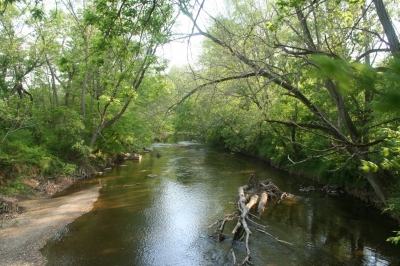 |
| There are many places at White Clay Creek where it's easy to forget you're right in the middle of a busy urban area. This is just one of them. |
Oh yeah, then there are the trains.
Forrest touches on that unexpected sense of isolation: “White Clay Creek has surprising beauty and tranquility within a fast-paced urban setting. There is the hubbub of the racetrack and slots, two railways, and routes 4 and 7 all around – yet when you’re trying to negotiate the bend in the river on hole #11, you can be whisked away into your own private golf refuge, enjoying the wild and scenic challenge that is unique to the White Clay Creek.”
That’s true – but again, an AMTRAK express train can be just down the tracks. It’s amazing how fast they sneak up on you, always ready to test your powers of concentration.
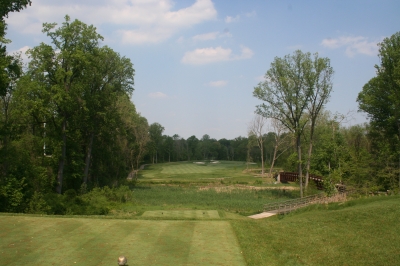 |
| It's a long way from the back tees to the fairway on the par four 6th hole. If you're going to play from the tips, you'd better pack length and accuracy, or you're in for a long day. |
Then there are the race sounds, which I actually found very pleasant. Sample says they’ve made no efforts to ‘hide’ the racing theme at White Clay Creek. “Being part of Delaware Park and its rich thoroughbred racing history, we’ve established tributes to the sport throughout the course, most notably in our flagsticks and tee markers, which are modeled after jockey’s helmets.”
The facilities are also top-notch, including a large practice range, chipping area, practice bunkers and a putting green. Inside the clubhouse, there are locker rooms, a sauna, steam bath and fitness room, which Sample says are the best in the area. White Clay Creek also offers an Academy of Golf, which houses a year-round indoor practice area.
One thing you won’t be able to do at White Clay Creek is walk the golf course. Sample explains: “The course is very spread out, which brings with it a lot of positive attributes, but walking isn’t one of them. In all, there are nearly nine miles of cart paths from the clubhouse throughout the golf course. In particular, there’s a long but very picturesque drive from the green of the second hole to the tee of the third hole – it takes you along the creek as well as behind our horse training track.”
It’s true – you could pen your own short story just on the trek from the second to third holes. One of the longest in-course cart rides I can recall, but it’s not distracting.
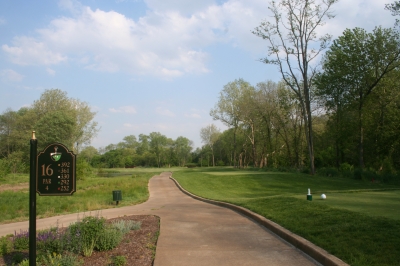 |
| With large, mature trees throughout the golf course, White Clay Creek has the look of a much older layout. Here, the par four 16th hole. |
And because the property is so vast, nearly every hole is self-contained. “There are only a few areas where there are overlaps in traffic from different holes,” Sample explained. “Even when the golf course is full to capacity, you still feel as if you’re the only one on the course.”
Hole highlights include the par four first hole, which immediately gives you an idea of what’s to come – because the green is separated from the fairway by the creek – and it’s not an itty-bitty span, either. There’s a bunker splitting the fairway landing area off the tee, so you can choose to go to either side, or over, if you can. But again, be aware of the creek!
The par four sixth hole is probably the scenic highlight at White Clay Creek, but if you’re playing one of the two back sets of tees, it’s a heck of a carry to get it to the fairway. Sample says the longest bridge on the course takes you from the back tees to the landing area – and you’ll grasp just what makes this hole so tough.
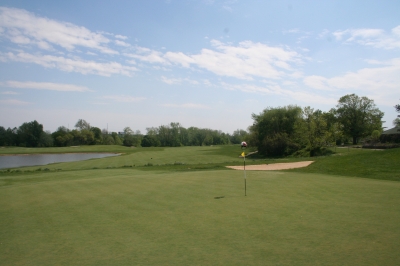 |
| The 593-yard, par five 3rd hole carries with it the #1 handicap label, and it's well deserved. |
On the back nine, the aforementioned eleventh hole is a very picturesque dogleg right, with the creek running along the right-hand side, protecting the leg. It’s tempting to try and blast it over, but even a slight miss to the right will bring the water into play.
Sample says her favorite hole is the par three seventeenth hole, with a large pond on the left side and grass bunkers on the right. It’s White Clay Creek’s shortest hole, but from the tee it looks like an awful lot of water’s between you and the green.
It’ll probably take a second round at White Clay Creek to fully appreciate it, as its ‘natural’ difficulty will probably surprise you the first time around. In addition to the dominant presence of the creek, the Hills/Forrest raised greens complexes will also challenge you to bring your best game here.
But it’s certainly worth making White Clay Creek part of your itinerary if you’re traveling to this part of the Mid-Atlantic. The service is excellent, and it’s convenient to local hotels and restaurants… and the horses, of course – all part of what makes visiting this new ‘track’ a definite must.
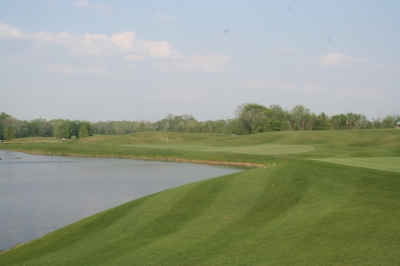 |
| The par three 17th hole is White Clay Creek's shortest and 'easiest.' But it's still got its own kind of charm. |
Where We Stayed
When we traveled to Delaware Park, we stayed at the Hilton Wilmington/Christiana, located just off Delaware Interstate 95, and minutes from Delaware Park.
Tel: 302-454-1500 Fax: 302-454-0233
From the Hilton website: Guests may relax in our Conservatory, enjoy our High Tea Service, and gaze upon our spectacular Hilton hotel courtyard. Envision being nestled by a fireplace, sipping a libation, while being pampered with personalized service in our elegant Hilton hotel Executive Lounge. Guests may enjoy a glass of wine from our Hunt Club lounge, and then participate in the fun of our popular tradition known as ‘Royal Swan Feeding.’
Details:
Telephone: (302) 994-6700
Website: whiteclaycreek.com
Designer: Arthur Hills/Steve Forrest & Associates
Head Golf Professional: Ryan Kidwell, PGA
Superintendent: Carey Bailey
General Manager: Bobbi Sample
Tees/Yardage/Slope/Rating
Gold 7007 75.0/140
Black 6467 72.2/135
White 5884 69.6/131
Green 5297 66.9/118, 71.1/127 (L)
Red 4612 63.2/111, 68.7/117 (L)
Rates:
Peak Season (May through September) -- $95; $75 after 2, $45 after 4.
Shoulder Season (April, October and November) -- $70 before 2, $55 after 2 and $40 after 4.
March and December -- $60 all day.
Closed January and February.
| Related Links | Comments on this article? | |
|
Maryland National Golf Club Hollow Creek Golf Club Rocky Gap Resort PB Dye Golf Club in Ijamsville Whiskey Creek Golf Club |
E-mail Jeff Rendall, Editor: jrendall@golftheunitedstates.com |











